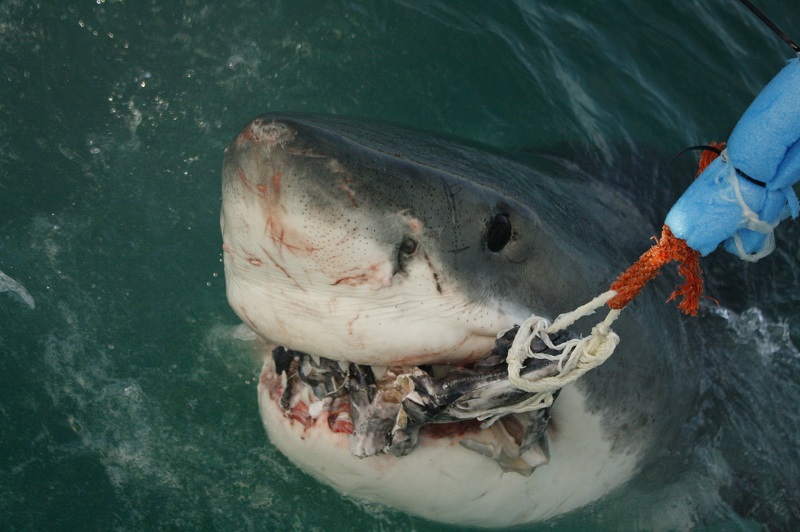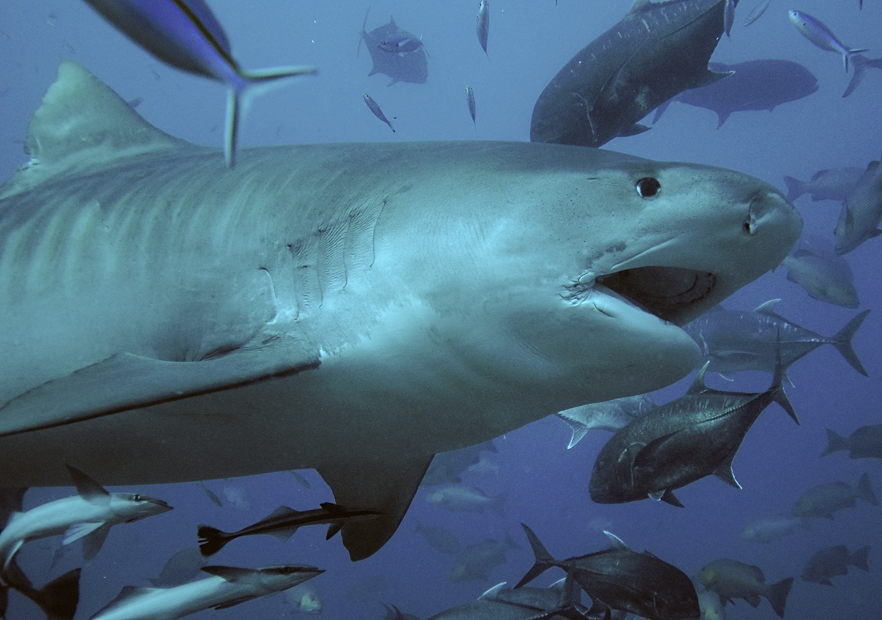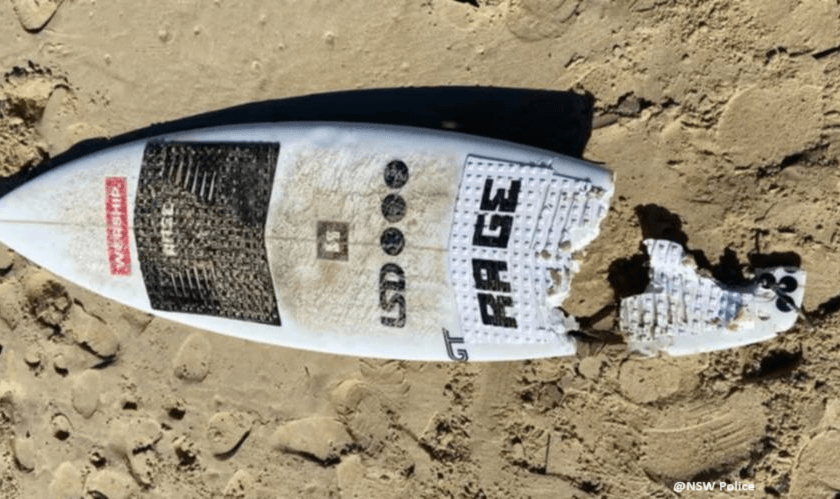Alex Wright has been sharing his experiences while working on a shark cage diving boat. In part one he traveled to South Africa, then to South Australia and finally to Guadalupe. Today he shares his thoughts on the experience.
![]()
“Every industry has its ups and downs, its pros and cons. Cage diving with Great Whites is no different, and certainly has its critics. Cage diving has been the only way for me to live my dream, and it is without a doubt the best way to see Great Whites in their natural habitat. In my opinion, the industry has not been around long enough to truly make a difference in the behavior and conditioning of Great White Sharks.
“Nothing is guaranteed to be 100 percent safe but being in a cage with a Great White can be safer than driving on the highway. Cage diving not only reduces the fear of sharks, it changes people. Without even realizing it, it changed me. I think no matter what, when we enter the water we must realize it’s not our domain and act accordingly.
“All 3 places have ties to conservation and they all conduct or help to conduct research and tagging efforts on Great Whites. There are research boats, where scientists and organizations will book the boat completely and tag the sharks, ID the sharks, all in the name of conservation. This is done in all locations, not just one. It is important to see all the good this industry has done for the Great White Shark.
“What really makes this industry are the clients, the guests, the people that come on board to see these animals for what they are, which are animals no more and no less.
Sure, most of the people go in to the cage to check it off their bucket list but there are certainly many that do it over and repeatedly for being in the mere presence of such a powerful and enigmatic animal.
![]()
“Those few that go into the cage because they’ve dreamed of it since they were a kid are more my type of people. Being in a cage in South Africa was the most exciting experience I have ever had with Great Whites. While there, I had the great pleasure of meeting Chris and Monique Fallows.
‘It was a dream come true, we set out on an early morning breaching trip where we did not see one breach. However, I towed the decoy and tangled up some fishing line where Chris came over and helped me untangle it. A great photographer with an easy-going personality, he helped make the experience a lot more enjoyable. I shot alongside him, shooting the seals and hoping for a breach.
“I feel as though the adrenaline in the cage is not as exciting as being outside the cage. Those that come on board to check off the bucket list have a slightly different experience than those that have been dreaming of it since being a kid, in my opinion. They may not really be in the moment as opposed to someone who has dreamed of the experience from a young age.
“One client in particular came on board and told me for two days how much he had dreamed of this moment. However, he was struggling to get in the cage and stay in. He waited until the second day of diving and I told him I want him in the cage because this was his dream. He had paid a lot of money and when I convinced him to get in the cage, seconds later the best shark action all trip had happened.
“Three or 4 sharks circled the cage, and there was breaches on both bait lines. He got out and everyone clapped, he turned to me and said thank you. That meant the world to me, even though the reasons we were there were different, his world had changed. His perception of the animal had changed because that is what happened with me. Sure he loved sharks just as much as I did, but there’s nothing like seeing them in person.
“Another memorable group was on the third trip of the season where Tabitha Lipkin, a Broadcast Journalist and Ms. Scuba 2014 came on board to report on shark cage diving for Fox 5 News San Diego. They were getting shots of the sharks and interviewing coworkers and clients. It was surreal to be a part of it.
“It is truly amazing what the shark brings together, it is such a work of God or the Universe. To feel their energy, their curiosity, and their raw power is unexplainable. I see it as the more people to see these animals in the wild, the larger the possibility of enacting real change and increasing the care for these animals.
“One of the last trips I was on had the pleasure of being Ralph Collier’s last trip to Guadalupe Island. He is the head and founder of the Shark Research Committee. I learned a lot from him, and it was truly a memorable last trip, and it ended the season for me.
“I enjoy making other people have an enjoyable time with the sharks. It can be tough at times, but nothing in this world worth having comes easy. I get to meet people from all over the world all for one common purpose, to see the Great White Shark.
“I have certainly received the question as to which location is the prime spot to cage dive with Great Whites. Personally, my favorite is South Africa. The visibility sucks, but that offers a more up close and personal interaction with the animals. The water is cold, but you do not notice it as much when a shark is swimming by you. The cages are small, but comfortable and the breathing system is simple.
![]()
“The best location really comes down to what the client is looking for. The visibility between South Australia and Guadalupe is close together along with the temperature of the water. The sharks at Guadalupe are more active, as compared to the ones I saw in South Australia. The only drawback I can think of when it comes to Guadalupe and shark cage diving is it is not year-round. The sharks migrate there between mid-late August and stay until January. All the other locations operate year-round.
“In February however, in South Australia the sharks seem to disappear for quite a few weeks. A few years ago, a pod of orcas came through the Neptune Islands and killed one of the Great White Sharks. For the 2 years after that attack, it seems they disappear for a few weeks around the same time. Personally, I believe the sharks leave the same time each year due to a cautionary feeling.
“Regarding the future, working with sharks has been a dream of mine since I was a kid. The past several years, I have worked with, dove with, and photographed sharks. I have no idea what the future holds in store for me and my passion for the ocean, the only thing I know is that I am constantly on the lookout for the next adventure and that whomever I meet, I will influence them. That is how I change the world, and that is how I inspire people to care about our oceans, by being the change and by showing people just how beautiful this planet is with my photography.
![]()
“I have been blessed with the experiences I have had, the people I have met, and the places I have been. The sharks, and the ocean is how I deal with life now, to just keep on going. Looking for the next great adventure, I know I will help the ocean, in the meantime I am doing all I can to get closer to the animals everyone else is too scared to understand. I am eternally grateful no matter how hard it has been I have gotten through it and I am a better person because of it. I am reborn in each new experience. I am better understanding of sharks and their behavior, and more importantly the way they capture my fascination and passion so easily.”
“A lot of people attack the sea, I make love to it.” Jacques Yves Cousteau
Those words are true for both Alex and me. Just like Alex, I worked on a shark cage diving boat in South Africa. I also went scuba diving with Great Whites in Guadalupe and Tiger sharks in the Bahamas – on both locations without a cage.
People who want to study the behavior of sharks must have the courage to get in touch with these predators. Many shark divers, therefore, seek a more personal encounter with sharks than watching them through thick steel bars. They want to know more about an animal that is so often misunderstood and that few of us really know.
The cage option cannot create the same experience. I did not choose to dive without a cage because I’m looking for an adrenaline rush, but because I wish to understand the sharks better. I have respect but no fear of them.
Sharks do not have a particularly good reputation. Their advocates are few and far between. That’s why I went on a mission with my camera and notebook to show that sharks are irreplaceable. I’m committed to get rid of the myth that these impressive creatures are prime man-eaters. I photograph and film the animals up close and have been able to make such unique experiences. I want to show the beauty and power of these apex predators and appeal to a different audience than most authors.
Although they are commonly portrayed in the media as blood-thirsty killers (think of JAWS and other movies), sharks have little interest for human flesh. As Drew Scerbo, admin of the White Shark Interest Group on Facebook, put it:
“I think it’s simply that sharks don’t know what a “human” is. There is a great wide world out there and humans only occupy 30% of it. I know it’s a hard concept for most to wrap their heads around…it’s hard for anyone to fathom, but only our lives revolve around us and sharks do not encounter people with any regularity enough to pay us much attention.
“Add to that, the fact that we probably taste awful. Yes, we’re protein, but think of everything we put on and in our bodies…chemical after chemical…even in the most remote regions.
“We also have a lot less of the type of fat that most sharks like – so, even when bitten, we don’t taste like the fish oils or seal oils that sharks prefer. They CANNOT develop an evolutionary taste for us because sharks and humans do not spend enough time in each other’s territory enough to develop an affinity for each other.
“You ever wonder why bees prefer specific flowers? Why lizards like bugs? Why birds like seeds? They have all developed a “taste” for their food types. We simply are far too different than anything they might like.
“I also believe that this is why only in extreme cases has a human ever been consumed; as a last resort, in desperation. You’d be amazed at how picky most organisms are when there’s a choice. Take for instance…if humans had no ability to cook or spice up dishes? What might you no longer be likely to eat?”
In my articles, I show my excursions into the depths of the ocean. The purpose is to awaken compassion and understanding for sharks – because what else stands in the way of these animals’ survival is our desire to extinguish them.
Every year millions of sharks are killed. Many people do not know that – and if they know it, some do not care. Due to extensive (and often illegal) hunting practices, the shark population has shrunk by 95 percent over the past two decades!
Sharks are killed for their flesh, teeth, cartilage (falsely thought to cure cancer), cod liver oil, for shark fin soup and their bodies to serve as a macabre interior. The precautionary killing of sharks also appears to have become a reflexive reaction of the government when swimmers collide with a shark. Australian Prime Minister Tony Abbot and his colleagues from Western Australia gained dubious fame a couple of years ago as they provided $ 20 million from the state budget for a four-year plan to kill sharks.
I think it’s easier to change people’s opinion by showing them photos and telling stories that help change their perspective and engage in dialogue. Thus, people are more open to the problems that threaten the survival of sharks. Regardless of whether they like sharks themselves or not, they still realize that sharks are an irreplaceable part of our ecosystem.
So, I jump into the water, swim as close as possible to the sharks … and still don’t get eaten. Unless I harass them or arouse the hunting instinct of sharks, these predators pose no threat to me. I do not say that we are dealing with harmless animals! But as long as we approach the sharks consciously and with respect, we can swim close to and even interact with them. And that’s what it’s all about for me: make people understand that you do not have to see sharks as terrible monsters that are out to get us.
With the extinction of the sharks, our entire ecosystem would collapse. These creatures are at the top of the food chain, so their survival is important to a healthy and balanced marine ecosystem. If the ecosystem in our oceans is permanently disturbed, it does not look good to the rest of the world either.
If you look at what’s happening in the ecosystems that make sharks disappear, it should give you shivers down your spine. Nothing is superfluous in nature. Unfortunately, we forget that too easily. We believe we could just intervene in the ecosystem and take out what we want.
Sharks have already survived five major species extinctions. Do we really want to get involved?
All photos courtesy of Alex Wright
![]()
Christian Kemper is a TV journalist from Germany. He has been diving with and studying sharks for more than 20 years. He has written two books about shark attacks and one book about crocodiles. He is a freelance writer for 3 of the biggest diving magazines in Germany.
You can find his German Language book Strange Pool Friends on Amazon and at tredition.
He has also written a three part article about how cage diving with great white sharks began.



